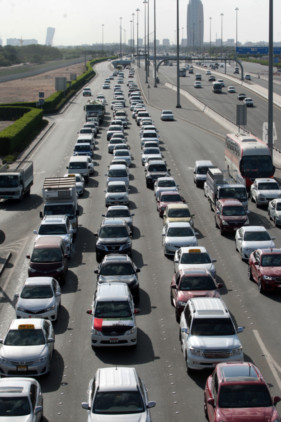
ABU DHABI Traffic on the Abu Dhabi-Dubai highway is becoming a nightmare during peak hours, say daily commuters. The exit and entry points of Abu Dhabi city are chock-a-block from 7 to 9 in the morning and from 3 to 5 in the evening.
“It’s hell on the highway,” said Rana Haddad, a Lebanese architect who commutes between Dubai and Abu Dhabi daily.
“It takes me 30 to 40 minutes to cover the last few kilometres just before entering the city,” said Haddad, 32, who lives in Dubai but works in Abu Dhabi.
She said she invariably gets stuck in the gridlock on the Shaikh Zayed Bridge around 8am every day.
“The stretch between Shaikh Zayed Bridge and my office takes forever. I feel trapped inside my car,” said Haddad whose office is situated on Shaikh Zayed Bin Sultan Street (previously Salam Street).
According to many who do the daily 300km grind between Dubai and Abu Dhabi, traffic congestion has gone from bad to worse.
“It is a nightmare in the morning to enter the city. It is equally bad in the evening between 4pm and 5pm,” said British IT consultant Andrew.
No respite
According to official figures released by the Department of Transport in Abu Dhabi last year, almost 11,000 vehicles enter the capital between 6 and 7am on a working day carrying between 16,000 and 20,000 people.
“We expected the congestion to ease up after Abu Dhabi government employees were asked to live in the emirate. But there seems to be no respite,” said Andrew who has been commuting from Dubai and back for the last three years.
Since September 2013, it became mandatory for government employees to live in Abu Dhabi if they were to retain their housing allowance. An estimated 10,000 government employees were affected by the rule.
One of the main reasons for issuing the directive was reportedly to ease mounting traffic and reduce accidents on the Abu Dhabi-Dubai highway. But the serpentine line of cars piling up at the entry and exit points of the city tells a different story.
Traffic woes during peak hours are, however, not limited to those commuting from Dubai alone. People living outside the city limits in Abu Dhabi’s newly developed residential areas like Mohammad Bin Zayed City, Khalifa City A, Al Muneera and Al Raha are also affected.
“It is a traffic deadlock on all the exit and entry points into the city. I have to leave before 7.30am from home to reach my office in Khalidiya at 8.30am becaue of the traffic bottleneck on Mussafah Bridge,” said Indian expat Abhilash Nair.
He moved from the main island to Mohammad Bin Zayed City in Mussafah three years ago because of high rents.
“I feel the amount of time I waste on the roads is not worth the Dh10,000 I save on rents,” said the civil engineer.
Likewise, another expat M.E. from New Zealand who lives in Raha Gardens said he is stuck between his house and his job in the city.
“If there was no traffic, you need just 20 minutes to drive to the city. That is why I took a house in Raha Gardens two years ago. But the traffic is driving me nuts,” said M.E. who did not want to reveal his full name.
Many expats are hoping the new highway (E311) connecting Dubai and Abu Dhabi, when completed, will reduce congestion on the existing (E11) main road connecting the two emirates.
E311 is one of the biggest infrastructure projects that the Department of Transport is working on as part of its Surface Transport Master Plan (STMP).
Work on the extension of Shaikh Mohammad Bin Zayed Road (E311) from Dubai connecting Al Sweihan Road (E20) in Abu Dhabi is expected to be finished by 2017.
The project is planned in two phases – the first is to construct a 34km stretch with three interchanges. The second will see the construction of 28km with three new interchanges and the modification of an existing one.




